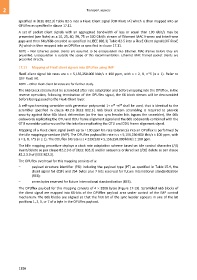Page 1190 - 5G Basics - Core Network Aspects
P. 1190
2 Transport aspects
specified in [IEEE 802.3] Table 82-5 into a FlexE Client signal [OIF FlexE IA] which is then mapped into an
OPUflex as specified in clause 17.11.
A set of packet client signals with an aggregated bandwidth of less or equal than 100 Gbit/s may be
presented (see Note) as a 10, 25, 40, 50, 75 or 100 Gbit/s stream of Ethernet MAC frames and interframe
gaps and then 64b/66b encoded as specified in [IEEE 802.3] Table 82-5 into a FlexE Client signal [OIF FlexE
IA] which is then mapped into an OPUflex as specified in clause 17.11.
NOTE – Non Ethernet packet clients are assumed to be encapsulated into Ethernet MAC frames before they are
presented. Encapsulation is outside the scope of this Recommendation. Ethernet MAC framed packet clients are
presented directly.
17.11 Mapping of FlexE client signals into OPUflex using IMP
FlexE client signal bit rates are s × 5,156,250.000 kbit/s ± 100 ppm, with s = 2, 8, n*5 (n ≥ 1). Refer to
[OIF FlexE IA].
NOTE – Other FlexE client bit rates are for further study.
The 66b block stream shall be scrambled after rate adaptation and before mapping into the OPUflex. In the
reverse operation, following termination of the OPUflex signal, the 66 block stream will be descrambled
before being passed to the FlexE Client layer.
58
39
A self-synchronizing scrambler with generator polynomial 1+ x +x shall be used, that is identical to the
scrambler specified in clause 49.2.6 [IEEE 802.3]. 66b block stream scrambling is required to provide
security against false 66b block delineation (as the two sync header bits bypass the scrambler), the 66b
codewords replicating the OTU and ODU frame alignment signal and the 66b codewords combined with the
OTU scrambler pattern used for the interface replicating the OTU and ODU frame alignment signal.
Mapping of a FlexE client signal (with up to 100 ppm bit-rate tolerance) into an OPUflex is performed by
the idle mapping procedure (IMP). The OPUflex payload bit rate is s × 5,156,250.000 kbit/s ± 100 ppm, with
s = 2, 8, n*5 (n ≥ 1). The ODUflex bit rate is s × 239/238 × 5,156,250.000 kbit/s ± 100 ppm.
The Idle mapping procedure deploys a clock rate adaptation scheme based on Idle control character (/I/)
insert/delete as per clause 82.2.3.6 of [IEEE 802.3] and/or sequence ordered set (/O/) delete as per clause
82.2.3.9 of [IEEE 802.3].
The OPUflex overhead for this mapping consists of a:
– payload structure identifier (PSI) including the payload type (PT) as specified in Table 15-9, the
client signal fail (CSF) and 254 bytes plus 7 bits reserved for future international standardization
(RES);
– seven bytes reserved for future international standardization (RES).
The OPUflex payload for this mapping consists of 4 3808 bytes (Figure 17-19). Scrambled 66b blocks of
the client signal are mapped into 66-bits of the OPUflex payload area under control of the IMP control
mechanism. The 66b blocks are aligned so that the first bit of the sync header appears in one of the bit
positions 1, 3, 5, or 7 of a byte in the OPUflex payload.
1180

